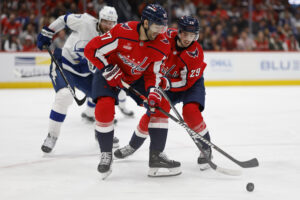Forward depth is absolutely vital in the modern NHL. Teams like the Colorado Avalanche simply cannot rely on one or two lines. That means teams have had to get more creative and aggressive over the years in constructing four quality lines. Teams even need to consider how good their 13th or 14th forwards are thanks to the rigours of modern hockey. The Colorado Avalanche forwards group has become one of the best in recent years. It will be put to the test whenever the upcoming season begins.
Colorado Avalanche Forwards Depth
Top-Six
Colorado’s top-six is absolutely frightening. There is reigning Hart finalist Nathan MacKinnon leading the way as one of the fastest and deadliest skaters in this generation. The former first overall selection from 2013 has reached 90+ points three times in seven years before turning 25-years-old. There is almost nothing he hasn’t done outside of win the Hart Trophy and the Stanley Cup.
All of those things might happen soon with a top supporting cast featuring Gabriel Landeskog and Mikko Rantanen. Landeskog is the team’s emotional leader thanks to almost 10 years with the organization and provides key two-way production. He’s cracked the 50-point barrier six times and two of the past three years with 100 or more hits on top of the scoring. There is always concern his physical play will cut into his play eventually, but there’s no concern of that right now. Rantanen is an absolute sniper who has scored 39 percent of his 250 career points on the power play. He’s dependant on playmakers like MacKinnon to set him up, but the 24-year-old is an outstanding complementary piece.
In case you thought it got easier after that group, Nazem Kadri, Brandon Saad, and Andre Burakovsky are an excellent second unit. Saad could move up to the top line in place of Landeskog, but that would alter line chemistry. It would also deprive MacKinnon and Rantanen of their veteran physical supporter. Either way, Kadri, Saad, and Burakovsky are poised to be one of the best lines in the NHL with 50-point potential. It lakes a certain flash of some second lines, but it has grit and will control the puck at a high level. This is a top-six that will terrify many opponents.
Bottom-Six
Acquiring Saad means that two players with top-six potential move down the depth chart. Those players are Tyson Jost and Joonas Donskoi. Donskoi was a consistent 30+-point contributor during his years with the San Jose Sharks. He also had positive possession numbers in each of his four seasons with the Pacific Division team. The possession stats fell slightly after joining Colorado, but the scoring remained steady. His role fluctuated somewhat in 2019-20, so a more consistent deployment strategy should only produce good things. Jost is a wild card poised for bigger things in his fifth season. The 10th overall selection from the 2016 Draft hasn’t lived up to the pick, but a permanent shift to the wing might be just what Jost needs.
The two will probably flank J.T. Compher, another steady skater who could break out when the season begins in 2021. The 25-year-old isn’t great at any one thing, but he has familiarity with Jost and helps shoulder some tough defensive starts. The key aspect of Compher’s third-line contributions. If he can increase his win percentage from a career 47.4 mark to 48 or 49 percent, that slight difference could be huge in controlling things even more.
That leaves a likely trio of Valeri Nichushkin, Pierre-Edouard Bellemare, and Matt Calvert on the fourth line. The is a quality group with borderline third-line upside. Each of the three scored over 20 points. Two of them, Nichushkin and Calvert, likely would have cracked the 30-point barrier before injuries and the spring shutdown occurred. All three were above the 50 percent Corsi For mark and all had positive relative Corsi scores despite defensive zone start rates at or above 55 percent. It’s an excellent line only limited by health at this point.
The Extras
The 13th and 14th forwards are probably Martin Kaut and Shane Bowers. Both are former first-round picks who started to adjust to professional hockey last season. Kaut debuted last year with two goals and three points in nine NHL games. He also scored five goals and 18 points in 34 games, which represented a slight increase in points-ger-game from the 2018-19 year. The 6’1″ Czech wing is currently doing fine overseas thanks to four goals and five points in 10 games. Those have been split almost evenly between teams in Sweden and the Czech Republic. Kaut looks like a fine skater for a third line who can play on special teams.
Next up is Bowers. He didn’t start particularly hot in 2019-20, but ultimately finished the year with 10 goals and 27 points in 48 games. That translates to a healthy .56 points per game for someone who is still just 21-years-old. The Ottawa Senators originally drafted the 6’0″ Bowers as a centre, but he might move to the wing as Colorado is very deep down the middle of the ice. His future role is roughly the same as Kaut’s unless he can play and dominate the coming year.
Then there is a collection of skaters on minimum contracts, the most interesting of whom is probably Logan O’Connor. The former University of Denver skater has scored at a higher rate than he did college, which gives him some intrigue as an energetic fourth-liner. 31 goals and 67 points in 104 games isn’t particularly impressive for someone in their early 20s, but there’s an enthusiasm that will make him a fan-favourite if he gets a regular role. At the very least, he shows some potential as a decent forechecking wing. O’Connor has 24 hits in 21 NHL games across two seasons.
General Thoughts
This is simply one of the deepest offensive units in the entire league. Assuming the season happens and provides enough games, Colorado could be one of the most dominant scoring teams we have seen in years. The top-six has four or five all-star-calibre players, all of whom can possibly break 60 points in a full 82-game season. Opponents also can’t sleep on the bottom-six given the presence of Donskoi and two potential breakout candidates.
This is a team that should excel in almost every game-state. The Avalanche finished third in total goals for, eighth in power-play goals, and sixth in shorthanded scores. Some might look at the team as a regression candidate based on expected versus actual goals from 2019-20, but the sheer amount of talent on the roster makes that hard to imagine. Injuries might not even be a big deal outside of MacKinnon. Almost every role has an effective substitute. There is nothing short of a catastrophe that should derail a forward group this talented and deep.
Main Photo:






